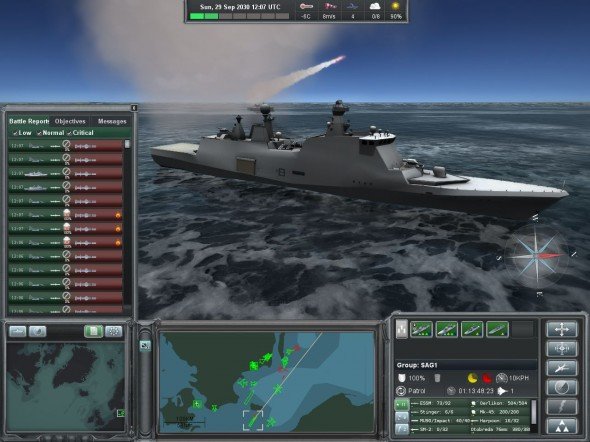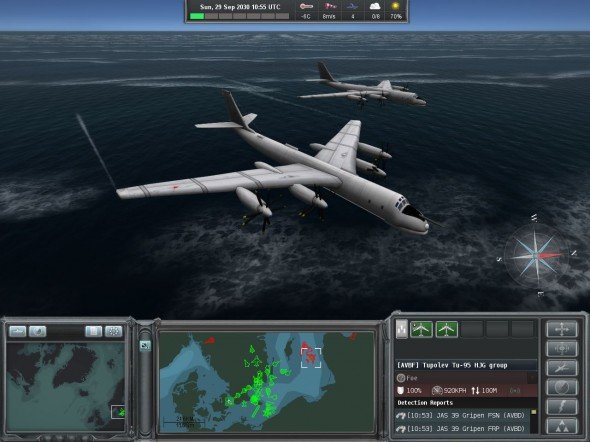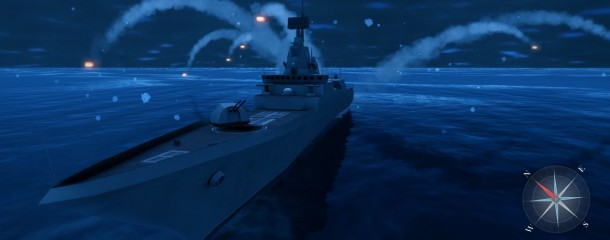Our Verdict
A welcome gulp of sea air for jaded real-time strategy fans, slightly tainted by campaign conservatism.
PC Gamer's got your back
I think I've just worked out why I auto-resolve most naval battles in Total War. Creative Assembly's briny barneys are criminally short of nuclear subs, AWACS aircraft, and antimissile missiles.
Two lines of wooden warships, 200 yards apart, cannoning the poop decks out of each other? Usually pretty dull. Two fleets of steel warships, 200 miles apart, trying to detect and destroy each other without being detected and destroyed? Invariably bally riveting.
Unless you're old enough to remember Jane's Fleet Command or the Harpoon series, this near-future turnless wargame is going to seem deliciously different. Tactics hammered into hippocampi by years of land-based RTSing are useless here. For once, there are no towns to occupy, no high ground to exploit, or forests to melt into. Try the maritime equivalent of a tank rush, and your 'tanks' will probably end up rushing towards the seabed long before they sight the enemy.

To prevail on NWAC's 35-million km2 North Atlantic battlefield, admirals must be half bloodhound, half pitbull. Often the most influential units are not the missilebristling frigates or the flocks of predatory jets (though these tend to do most of the destructive donkeywork) but the radar and sonarequipped helos and early-warning planes. It's the vulnerable E-3 Sentries and E-2 Hawkeyes that are usually the first to spy the chilling swarms of inbound anti-ship missiles. It's the Seahawk helos with their dipping sonar and jettisonable sentinel buoys, that are frequently the finders of massively dangerous Russian subs.
In truth, NWAC is as much about aerial tactics as naval ones. When you aren't setting up patrol areas for land or carrier-based fighters (dead simple thanks to a nifty click-anddrag order system) you're fretting over where to position tanker planes, or nibbling your nails as aircraft re-arm and refuel on the ground. Where another more obsessive developer would have swamped us with micromanagement and naval mumbo-jumbo, Turbo Tape keep things nice and simple. Occasionally you'll order an altitude or speed change, or tweak combat behaviour to encourage caution or ammo economy, but usually, interaction with assets is limited to 'Go there' and 'Kill that'. Once in range, a unit's inherent self-preservation and targeting instincts kick in, leaving you free to watch and pray.

The Norwegian devs might have pitched the complexity inchperfectly, but their campaign approach is sure to generate disgruntlement in some quarters. I'm willing to put up with missions arranged in rigid line-astern fashion – especially when they're as thoughtfully fashioned, varied, and soused with colourful character dialogue as the ones here – but a spot of scenario choice, unit carryover, or pre-clash force building, would have made a second playthrough far more enticing. The 23 story episodes might as well sit in the single battles folder for all the continuity they offer.
Someone seems to have forgotten to lash down the skirmish generator, scenario editor, and mid-mission save function, too. They all appear to have been washed overboard. Omissions like these, together with some slowdown during busy scraps, and visual tomfoolery in the 3D mode (ships will sometimes teleport to new formation positions, fixedwing planes rise like helicopters) don't prevent Naval War: Arctic Circle delivering tense, fresh, challenging engagements, but they might explain why the launch price is unexpectedly low in the water.
A welcome gulp of sea air for jaded real-time strategy fans, slightly tainted by campaign conservatism.


